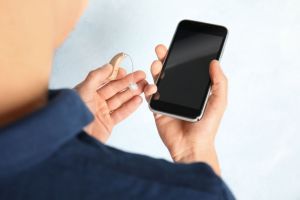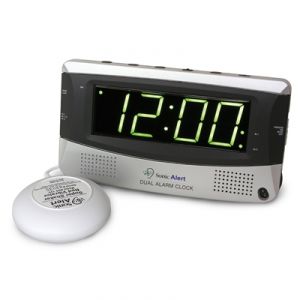If you have hearing loss, it is likely hearing aids will be a tremendous help to you in your daily life. But what about situations when your hearing aids aren’t quite enough? First, make sure you’ve read up on tips for communicating with hearing loss. Next, look into assistive listening devices (ALDs), which are useful helpers for listening to conversations on the phone, watching favorite shows on television, watching performances or speakers in public places and classrooms and even waking to an alarm clock in the morning or hearing the doorbell.
There is a surprisingly large array of ALDs on the market today. Some of these devices are made to work specifically with certain hearing aids while others are stand-alone and can be helpful—even if you don’t yet wear hearing aids. And increasingly, smartphones can serve as their own unique ALDs, especially when paired with modern hearing aids equipped with Bluetooth. Many hearing aid manufacturers now make accompanying hearing aid apps that give the user lots of control over their device, allowing them to stream the
Table of Contents
Types of assistive listening devices

captioning conversations for you, or serving
as a vibrating alarm clock, for example.
Hearing aid apps also provide many
ALD-like tools.
Assistive listening devices include amplified telephones, hearing aid compatible phones and smartphones, television compatible devices, FM systems for public settings, and alerting devices.
Amplified telephones
Amplified phones are specifically designed for people with hearing loss, allowing you to turn up the volume as necessary to hear speech clearly. You do not need to wear hearing aids to benefit from these devices. They can make it easier to hear high-pitched sounds, the same sounds many people with hearing loss are missing. These phones sometimes also feature amplified ring tones so you’ll never miss a call.
Hearing aid compatible phones
By law, telephone manufacturers must make phones compatible with hearing aids. This includes smartphones like iPhones and Androids. Hearing aid compatible phones generally use either acoustic or telecoil coupling. Acoustic coupling picks up and amplifies sounds from the phone as well as any noise around you. Telecoil coupling requires your hearing aid to be equipped with a telecoil, a special feature that only picks up the phone signal for amplification. Telecoils in hearing aids are desirable for people with more advanced hearing loss because background noise is blocked out during phone calls. They are a great help for people who spend significant time on the phone or those who use other telecoil-based ALDs such as induction loops in public places.
Additionally, phone apps can serve as their own unique ALDs. For example, caption apps can provide text translation for speech.
Assistive listening devices for televisions
When you have trouble clearly understanding or hearing the television, watching your favorite shows can become a chore. Turning up the television isn’t always the best option since it can make sound distorted and even more difficult to understand. And, when you’re watching TV with others, maxing out the volume isn’t always a popular option. There are several television ALDs that can work for you whether or not you already wear hearing aids.
Some television amplifiers work even without hearing aids. For example, TV Ears® is a popular and relatively inexpensive wireless headset with a personal volume control that plugs directly into your TV’s earphone socket.
FM systems for public settings
While not a new technology, an FM system is a dependable and very effective wireless technology that makes it easier to understand what others are saying in noisy situations, like classrooms or public events. The FM system consists of a transmitter microphone used by the person speaking in front of an audience and a receiver used by the hearing aid wearer. An FM system ensures the speech signal is delivered directly to both hearing aids. There are options for completely blocking out background noise while wearing it or allowing an optimal combination of speech and some background noise. These systems are widely used in schools to help children with hearing loss achieve their educational goals but they are also helpful for adults in many situations.

and vibrations to wake you.
Alerting devices
Most ALDs help make listening easier, but some also help you stay connected to what is going on around you and improve your safety. These alerting devices rely on amplified sounds, visual cues and even vibrations to alert you to sounds in your environment.
Some examples of alerting devices include:
- vibrating alarm clocks to help you start your day on time
- doorbell alerts that use flashing lights to let you know a visitor is at your door
- vibrating and flashing smoke and carbon monoxide detectors.
These devices can give you peace of mind and help keep you safe, even during those times when you may not be wearing your hearing aids.
Summary
Hearing aid technology is impressive and can be a big help for people with hearing loss. However, if you have unique needs that aren’t addressed by your hearing aids or if you aren’t yet ready for hearing aids, assistive listening devices can be the answer.


